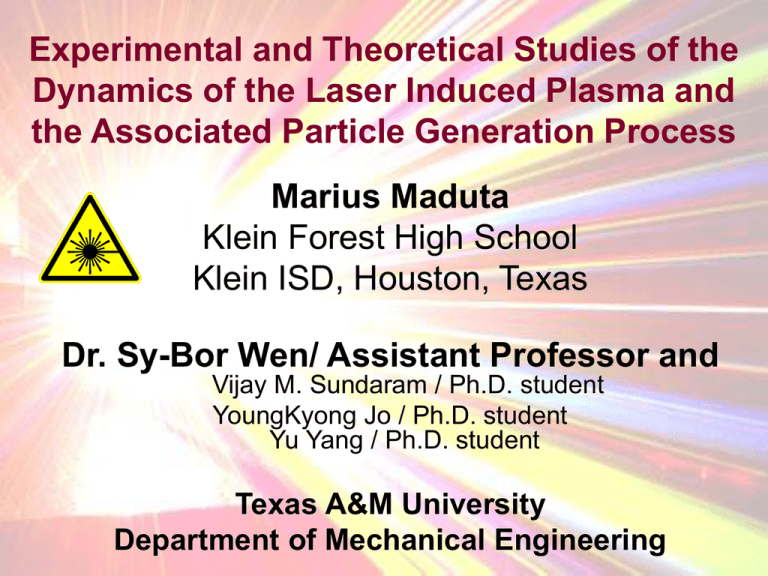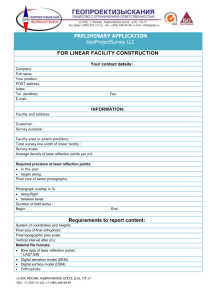What is total internal reflection?
advertisement

Experimental and Theoretical Studies of the Dynamics of the Laser Induced Plasma and the Associated Particle Generation Process Marius Maduta Klein Forest High School Klein ISD, Houston, Texas Dr. Sy-Bor Wen/ Assistant Professor and Vijay M. Sundaram / Ph.D. student YoungKyong Jo / Ph.D. student Yu Yang / Ph.D. student Texas A&M University Department of Mechanical Engineering What we have been looking at… Generation of Core Shell Quantum Dot Nanoparticles with Double Pulsed Laser Subdiffraction Limits Optical Detection Fabrication What we have been looking at… Ultra High-Speed and High Specially Resolved Temperature Measurements Inkjet – High Repetition rate nano-inkjet What my classes are going to do in order to touch upon some of the concepts applied in this lab (aspects of the research that are being bridged into my classroom): Heat transfer and temperature measurements were aspects of the lab work Reflection and Refraction as underpinning principles of electromagnetic radiation propagation. –Total Internal Reflection, as shown in optic fibers. –Collimation, as an application of refraction. The pertinent STAAR and TEKS applicable: The student will demonstrate an understanding of waves and quantum phenomena. (P.7) Science concepts. • characteristics and behavior of waves. • wave propagation • wavelength (and what it means in the visible range) • electromagnetic waves and electromagnetic spectrum • reflection, refraction • describe and predict image • industrial applications (P.8) Science concepts. • photoelectric effect • mass-energy equivalence • radiation therapy Heat Transfer using a laser beam Heat Transfer using laser beam will be performed by the instructor, as a demo, as an introduction to lasers (special safety considerations and equipment availability limit the students’ hands-on involvement at this point). a. Heat Transfer by lasers using a balloon b. Heat Transfer by lasers using matchsticks. Each class will be divided into three groups … and each group will design one setup and then present it before the class. Group 1 – Design a set-up that shows total internal reflection. This group will have one or two laser pointers (different colors), one water bottle and water. Questions to answer: What is reflection? What is total internal reflection? What are some applications in technology of total internal reflection? Each class will be divided into three groups … and each group will design one setup and then present it before the class. Group 2 - Design a set-up that shows total internal reflection for optical fiber. This group will be given a laser pointer and a piece of optical fiber. Questions to answer: What are Fiber Optics? How does an Optical Fiber transmit light? What are some applications of Fiber Optic technology? Each class will be divided into three groups … and each group will design one setup and then present it before the class. Group 3 - Design a set-up that shows light transmission through optic fibers, and a measurement of both the initial intensity as well as the intensity of the light as it is emitted from the optic fiber. Questions to answer: How do the two intensity measurements compare? What accounts for the difference in intensity? Is light “lost” in the optic fiber? What happens when the optic fiber is bent excessively? What is different between the red laser and the blue laser? All Groups 1. Refraction – In groups of three, design two experiments using any materials available in the lab in order to show refraction. Explain and diagram the law of refraction (Snell’s Law). 2. Collimation with two convex lenses. In groups of three, design and diagram an experimental set up using the ray box available in the lab, or two laser pointers, as well as two convex lenses. Explain the ray geometry involved. Ray Diagram Example (what the students should have for the Collimation problem). Convex Lens Convex Lens Ray Box Focal length Outline of daily activities of the classroom project: Day 1: A brief introduction of Lasers, definitions and terms. An introduction to laser safety will be presented (possibly a pre-test). The students must first pass the laser safety test (will allow two days for preparation for this test). Day 2: Engineering Design lesson – a brief overview of some of the basic concepts and principles. The groups will be assigned (three to four students per group). Hand out the assignments. Day 3: Laser safety test will be administered. Group 1 – Design a set-up that shows total internal reflection. This group will have one or two laser pointers (different colors), one water bottle and water. Group 2 - Design a set-up that shows total internal reflection for optical fiber. This group will be given a laser pointer and a piece of optical fiber. Group 3 - Design a set-up that shows light transmission through optic fibers, and a measurement of both the initial intensity as well as the intensity of the light as it is emitted from the optic fiber. Outline of daily activities of the classroom project: Day 4: Student design time – the students will collaborate with their teams to find solutions and come up with design ideas. Day 5 and Day 6: Design trial and re-design time. Realistically, we will need two days for this phase. Since each group will need some set-up time, we will need approximately 20 minutes for each group to set up and perform their demonstrations. Day 7: Final design presentations – 15 minutes per team. Day 8: Post-test – terms, definitions, problems. Examples from the lab . . . Total internal reflection – red laser following through a stream of water. Examples from the lab . . . Total internal reflection – red laser following through a stream of water. Examples from the lab . . . Can you tell what color this is? It’s actually red and green combined. They combine to give our eyes the impression of yellow! Examples from the lab . . . And a blue laser! Or is it purple . . . ??? Examples from the lab . . . Total internal reflection through Fluorescein. How many segments of light can you see? Examples from the lab . . . Focusing the beam inside the Fluorescein. What color is this laser? It is actually a blue laser beam that shines through Fluorescein, where the shorter wavelength is absorbed and longer wavelengths are emitted. Heat transfer 1. If the heat transfer is not fast enough, the material in the balloon loses the accumulated heat to the environment . . . 2. The darker color balloon will absorb the heat fairly quickly, and the balloon will melt. 3. The black balloon is inside the white balloon. Which one will absorb the heat faster? 4. Just for kicks . . . Can you guess what’s going on here? 5. So what exactly is happening? Why do the balloons pop? Pre-Test and Post-Test Challenge Pre-Test and Post-Test Challenge Acknowledgements E3 RET Program Coordinators Texas A&M National Science Foundation Mechanical Engineering Dept Dr. Sy-Bor Wen and his Lab Team … and the 2011 E3 Participants 23






